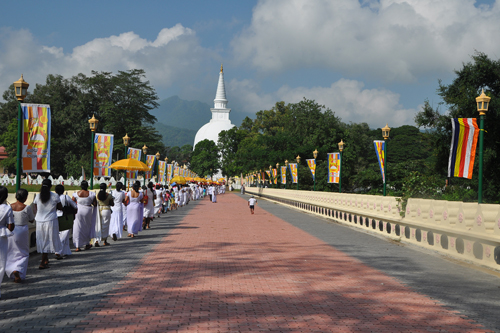Ancient stupa with links to Buddha’s own lifetime
 The Mahiyangane stupa rises against the blue ring of the Uva hills. Here in the lap of the eddying Mahaweli, stands a timeless shrine. Also called Bintenne and Alut Nuwara, this shrine according to legend goes back to the Sixth Century BCE and its oldest known reference is connected to the Mahavamsa legend of the Buddha’s first visit to the land ‘where His doctrine is to flourish’.
The Mahiyangane stupa rises against the blue ring of the Uva hills. Here in the lap of the eddying Mahaweli, stands a timeless shrine. Also called Bintenne and Alut Nuwara, this shrine according to legend goes back to the Sixth Century BCE and its oldest known reference is connected to the Mahavamsa legend of the Buddha’s first visit to the land ‘where His doctrine is to flourish’.
After a long drive from the central highlands before descending here into the eastern dry zone – typical plains Veddah country- it is a destination where pilgrims feel rejuvenated.
At the time of the Buddha’s visit, Yakkas were the sole denizens here and tried to intimidate the Buddha. However the Buddha pacified the beings (depicted as burly figures with fangs and prodigious pot bellies) and drove them to the Giridvipa (‘rock island’).
Today, in the image house of the Mahiyangane Raja Maha Vihara this story is told in the murals. It is a long tale, but one that can bear a potted repetition.
After conquering those demons, a regional ruler called Saman who was also of the Yaksa tribe (today Sumana Saman, the god of Adam’s Peak) begged for a lock of the Holy One’s hair and had it enshrined in a small stupa of diamonds.
The present bell shaped stupa is very striking to the pilgrim’s psyche with all its connections to the Buddha’s own lifetime. After god Saman, the Arahat Sarabhu raised the stupa to 12 cubits also enshrining the left collar bone relic of the Buddha, taken from the funeral pyre.
Prince Uddhaya Culabhaya, brother to Devanampiyatissa, made it 30 cubits high but by Dutugemunu’s time (circa 2nd Century BC) with the South Indian invasions things were in a dilapidated state.
Dutugemunu is said to have paused his battle against the Cholas in order to restore this mother of stupas and brought it up to 120 feet. It was only after this was done (says the Mahavamsa of its favourite monarch) that he set out to wage war against the Cholas.
Voharaka Tissa (204-236) renovated the vihara and added a parasol. Sanghabodhi the martyred king, who was brought up in a temple, did much to for its upkeep. Sena II (850-885), Kassapa IV (896-913) and Vijayabahu I (1058-1114) did more than keep the jungle tide at bay.
Up till Narendrasinghe, the last Sinhalese king, good care was taken of the stupa but by the 19th century, the jungle tide had claimed it, as R. L. Spittel would record in the 1920s, a sad if awe-inspiring ruin.
Mahiyangane was later the first stupa to be restored in modern times, a process that began in 1953, under the guidance of D. S. Senanayake and his son Dudley.
When it was ceremonially opened in 1961, on the pinnacle was a crystal-cut gem – a gift from Myanmar, the biggest of its kind of Sri Lanka, weighing 14.5 kg (32 lbs).
Apart from this, the temple houses one of the main Saman Devales of the island. While not as propitiated as the Maha Devale in Ratnapura, the former Yaksa chief who morphed into a benevolent god has a strong aura here.
Today, the temple also has a Bodhisattva statue , as big as the Dambegoda bodhisattva.
The perahera of the Mahiyangane vihara takes place in the month of Esala (July/August) and features the Veddahs who don their leaf and bark dress of yore.
Searching for an ideal partner? Find your soul mate on Hitad.lk, Sri Lanka's favourite marriage proposals page. With Hitad.lk matrimonial advertisements you have access to thousands of ads from potential suitors who are looking for someone just like you.


